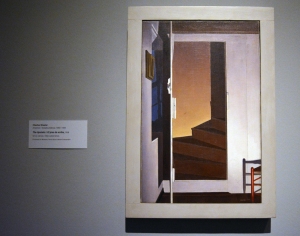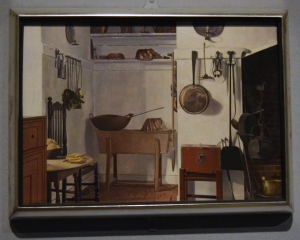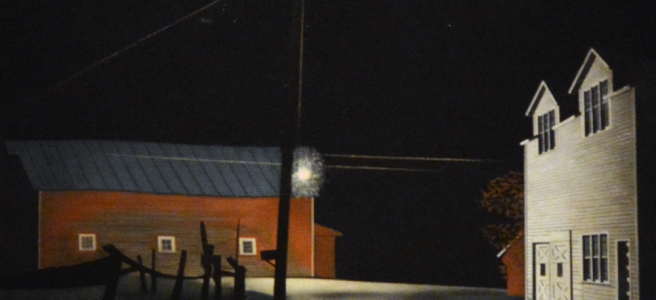I’d like to think modernity is transcendent of tribalism. I’d like to think the modern era arose from a clash of cultures, a dynamic explosion of diverse ideas that came together principally in America’s big cities. I’d like to think modernity represents a clean break from the past. What I’d like to think clashed with printed messages contained in the traveling art exhibit Cult of the Machine.

A worthwhile show with well-known paintings currently on view at the Dallas Museum of Art (DMA), the machine cult seems to break up in the final room. After traveling through skyscrapers, the inner workings of clocks, trains, and industrial scenes, we are presented with images of rural life. One work by Charles Sheeler presents a stairway that looks like Raphaelle and Titian Peale may soon descend it. Another painting is also absent of harsh metal and soaring structures and seems to want a Wallace Nutting rug.
There are barns, kitchen pots, and general homeyness though the precisionist treatment remains. This an odd fit, and in a way the most interesting room of the exhibition. The content and context here raise some intriguing questions about modernism, these artists, and machine-age art.
Why, in the end, does this movement, or at least artists associated with this movement, revert to views of rural America and colonial-era objects?
The label provides clues: Artists such as O’Keeffe, George Ault, and Charles Sheeler found aesthetic inspiration in the simple geometries of a barn or Shaker interior. The prevalence of precisionist art of such rural subjects, which harked back to the nation’s pre-industrial roots, reflected a larger national narrative that claimed the functionalism and efficiency of the modern era could be traced to the colonial period. This perspective may also reflect the nativism of the period— marked by frequent assertions of Anglo-European cultural dominance and calls for assimilation— that accompanied increased levels of immigration.
I had to read that, then re-read it, then take a picture. Are the curators attributing Euro-centric nationalism and nativism to O’Keeffe and Sheeler? Come to think of it; I’ve previously seen primitivism associated with contemporary art at museum shows. The 2009 Thomas Chambers exhibit at the American Folk Art Museum comes to mind.
Here though, I find the Euro-nationalist, anti-immigrant explanation a heavy charge to render, at least without providing more supportive evidence. The burden should not be on me, the visitor, to come up with a treasure of background knowledge containing world-views of Ault, Sheeler, and O’Keeffe.
Like most of us, I am standing in this DMA gallery and operating with limited background information.
My sense is the Cult of the Machine follows the career of Sheeler. Other artist’s works fit into this timeline. But Sheeler seems to be the main character in this story. His paintings best glorify the machine age and now and then revert to more primitive subjects.
The paintings in this room all hang below a quote from Sheeler:
“I don’t like these things because they are old, but despite it. I’d like them still better if they were made yesterday because they could afford proof that the same kind of creative power is continuing.” Charles Sheeler, 1938

Do antique objects and buildings contain the recipe for modernism? If so, how? Is it the industriousness, the culture, the form of government? But even then, why look back and not forward? To me, there must be more human, rather than philosophical reasons to tackle these subjects. Could it be a simple want of new material?
There’s little doubt the machine age has its roots in urbanism. Artistic activity and creativity also had its roots here, even in colonial times. A press release for the show talks about the coldness, the sublimity, and the strangeness of the mechanistic societies in which the artists lived.
It might be a stretch to say that modernism has some sort of roots in rural, colonial America. If it did, it may be the case that modernism is magnificent and awe-inspiring, but at the same time incredibly destructive.
I reached out to my favorite book on modernity, Marshall Berman’s 1982 All That Is Solid Melts Into Air. Without searching, I somehow opened it to a quote from Berman discussing perhaps the most influential urbanist, Jane Jacobs. Berman writes:
“Jacobs’ point of view is that the so-called modern movement has inspired billions of dollars’ worth of ‘urban renewal’ whose paradoxical result has been to destroy the only kind of environment in which modern values can be realized.”
Modernism, in this sense, is a mesmerizing cancer that eventually destroys at least the food its host survives on. It’s not lost on many familiar with Jacobs’ work that her final book was aptly titled Dark Age Ahead.
While Ault’s paintings are haunting and O’Keefe’s paintings are daring, I do feel a genuine appreciation of the subject matter in the work of Sheeler, whether that subject be an airplane, buildings in shadow, or an antique chair.
I also think if appreciation for these things can be lost to a changing age and demographic, then surely appreciation for this work can be lost as well. I hope that is not the case for either.
Top: Bright Light at Russell’s Corners by George Ault
Discover more from Urban Art & Antiques
Subscribe to get the latest posts sent to your email.


